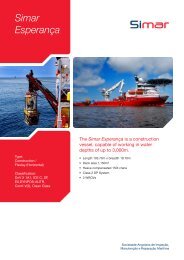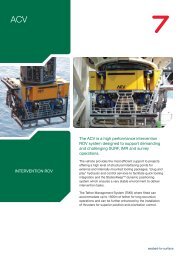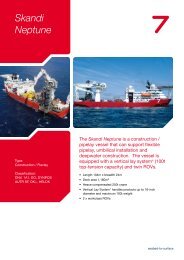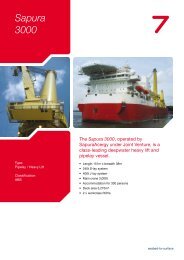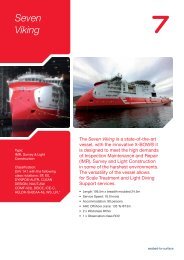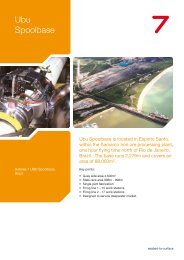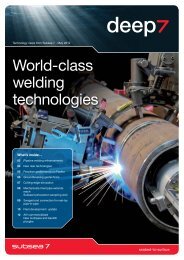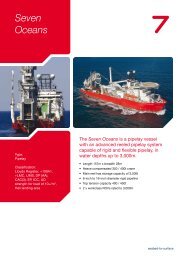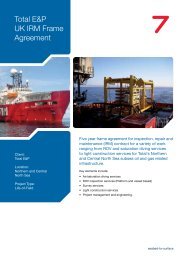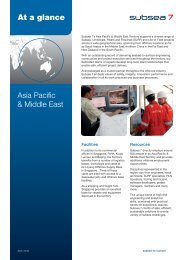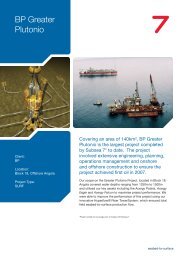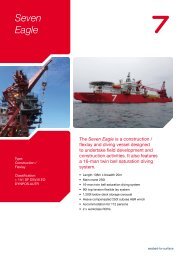Deep 7 - May 2013 - Subsea 7
Deep 7 - May 2013 - Subsea 7
Deep 7 - May 2013 - Subsea 7
Create successful ePaper yourself
Turn your PDF publications into a flip-book with our unique Google optimized e-Paper software.
14<br />
Heaviest and deepest<br />
subsea lifts<br />
Marin Abélanet, Engineering Director,<br />
Asia, Australia and New Zealand<br />
<strong>Subsea</strong> 7 has been awarded a contract<br />
by Chevron Australia for the Heavy<br />
Lifts and Tie-ins scope for the Gorgon<br />
Project, which is developing the<br />
Gorgon and Jansz-Io gas fields off the<br />
northwest coast of Western Australia.<br />
The contract will see <strong>Subsea</strong> 7 deploying<br />
some of the largest and heaviest subsea<br />
structures in the industry to date.<br />
At the Jansz-Io field, there are a total of<br />
six structures with a total weight in air of<br />
circa 3,500 tonnes which will be lowered<br />
to the seabed at an average depth of<br />
1,300m.<br />
In order to deploy these large structures<br />
safely and efficiently to the deepwater<br />
section of the Jansz–Io field, <strong>Subsea</strong> 7<br />
is investing in a customised deepwater<br />
lowering system, which will be selfcontained<br />
and mobilised as a single unit<br />
on board the heavy lift vessel<br />
Sapura 3000.<br />
This lowering system comprises two<br />
identical capstan traction winches of<br />
180t capacity, reeved in four falls with<br />
6,000m of wire. It has a maximum<br />
dynamic capacity of 1,300 tonnes at<br />
1,300m and will be delivered later in<br />
<strong>2013</strong>.<br />
The large structures will be offloaded<br />
from the transport barges using the<br />
vessel’s 2,600t capacity main crane and<br />
transferred via a lowering beam to the<br />
<strong>Deep</strong>water Lowering System. They will<br />
then be deployed directly in one single<br />
operation to the seabed.<br />
This latest addition to <strong>Subsea</strong> 7’s<br />
range of heavy lift subsea equipment<br />
<strong>Deep</strong>water lowering system<br />
will open new opportunities for the<br />
deployment of larger, heavier elements<br />
of subsea infrastructure in future<br />
deepwater developments.<br />
* The Gorgon Project is operated by an<br />
Australian subsidiary of Chevron and is a<br />
joint venture of the Australian subsidiaries<br />
of Chevron (47.3 percent), ExxonMobil (25<br />
percent), Shell (25 percent), Osaka Gas (1.25<br />
percent), Tokyo Gas (1 percent) and Chubu<br />
Electric Power (0.417 percent).<br />
For further information contact<br />
Marin.Abelanet@subsea7.com<br />
Improving vessel utilisation<br />
<strong>Subsea</strong> 7 is currently working on a number of new severeweather<br />
technology initiatives to enhance operations in<br />
challenging sea states. One is a crane lifting aid under<br />
development by <strong>Subsea</strong> 7 designed to improve deckhandling<br />
safety during lifting and with the potential to<br />
significantly extend winter-weather operations in harsh<br />
waters like the Norwegian Sea.<br />
The Universal Launch Assistant (ULA) is a load-controlling<br />
mechanical arrangement attached to the crane pedestal of<br />
existing vessels and controlled by the crane operator. Its<br />
telescopic arms swivel around the crane pedestal, and give<br />
firmer and safer handling of horizontal inertia loads including<br />
templates, manifolds and associated spools even in sea<br />
states above the current limiting range of 1.5-2m significant<br />
wave height.<br />
The ULA replaces the use of winches with holdback wires<br />
which are conventionally used to control horizontal loads, and<br />
therefore enhances on-board safety as well as significantly<br />
improving the utilisation of vessels involved in construction<br />
work in challenging weather conditions.<br />
A traction ring and slider arrangement allows the main structure and the<br />
telescopic arms to swivel through 360° around the crane pedestal. The<br />
Master and Auxiliary telescopic arms extend and retract in order to reach the<br />
equipment on the deck and facilitate load damping, enhancing the operational<br />
efficiency of vessels involved in construction work.<br />
For further information contact<br />
Sigbjorn.Daasvatn@subsea7.com<br />
DEEP7 <strong>May</strong> <strong>2013</strong>



